
An Ultra Big Data Platform
for Reducing Social Risks
for Reducing Social Risks
Program Manager
Hiroshi Harada
Hiroshi Harada
1995 Received Ph. D. from Osaka University Graduate School (engineering). Joined the Communications Research Lab of the Ministry of Posts and Telecommunications (Currently NICT)
1997 Researcher, Delft University of Technology, The Netherlands
2009 ~ Vice-chairman, IEEE802.15.4g, The United States
2011 Director of the Smart Wireless Laboratory, NICT
2012 ~ Founder and board co-chair of the Wi-SUN Alliance, The United States
2014 ~ Professor, Graduate School of Informatics, Kyoto University
2015 ~ ImPACT Program Manager
1997 Researcher, Delft University of Technology, The Netherlands
2009 ~ Vice-chairman, IEEE802.15.4g, The United States
2011 Director of the Smart Wireless Laboratory, NICT
2012 ~ Founder and board co-chair of the Wi-SUN Alliance, The United States
2014 ~ Professor, Graduate School of Informatics, Kyoto University
2015 ~ ImPACT Program Manager
Profile
Dedicatedly pursued R&D, standardization, and commercialization of wireless communications for 20 years. Has obtained 200 Japanese patents. Has successively served as the chair or sub-chair for over 10 standardization committees for the US IEEE 802 and 1900 international standards with submissions of over 800 proposals. Of note is the proposal for the Wi-SUN smart meter wireless communication standard. Wi-SUN has been adopted as the next generation wireless communication standard for smart meters by Japanese power companies that domestically own approximately 100 million utility meters.
Dedicatedly pursued R&D, standardization, and commercialization of wireless communications for 20 years. Has obtained 200 Japanese patents. Has successively served as the chair or sub-chair for over 10 standardization committees for the US IEEE 802 and 1900 international standards with submissions of over 800 proposals. Of note is the proposal for the Wi-SUN smart meter wireless communication standard. Wi-SUN has been adopted as the next generation wireless communication standard for smart meters by Japanese power companies that domestically own approximately 100 million utility meters.
What's New
Overview
There are more than 100 billion network-ready sensor devices around the world but as of 2013 only a small percentage of these devices
were actually connected and capable of sending data. More so, there is no existing platform capable of processing several 10’s of billions of
data records in several minutes. To address this, we will construct an ultra big data platform that far exceeds the scale of today’s big data
processing. Using this platform, we will use national and local public medical data and continuous measurement data to offer predictive and
preemptive healthcare and medical services, through which we will achieve Health Security that helps extend healthy life expectancy and
reduce medical costs. We also will aim to realize the social application of Factory Security, which will help eliminate cyberattacks on
factories and improve productivity and profitability by safely connecting control devices in factories into groups of one thousand units. 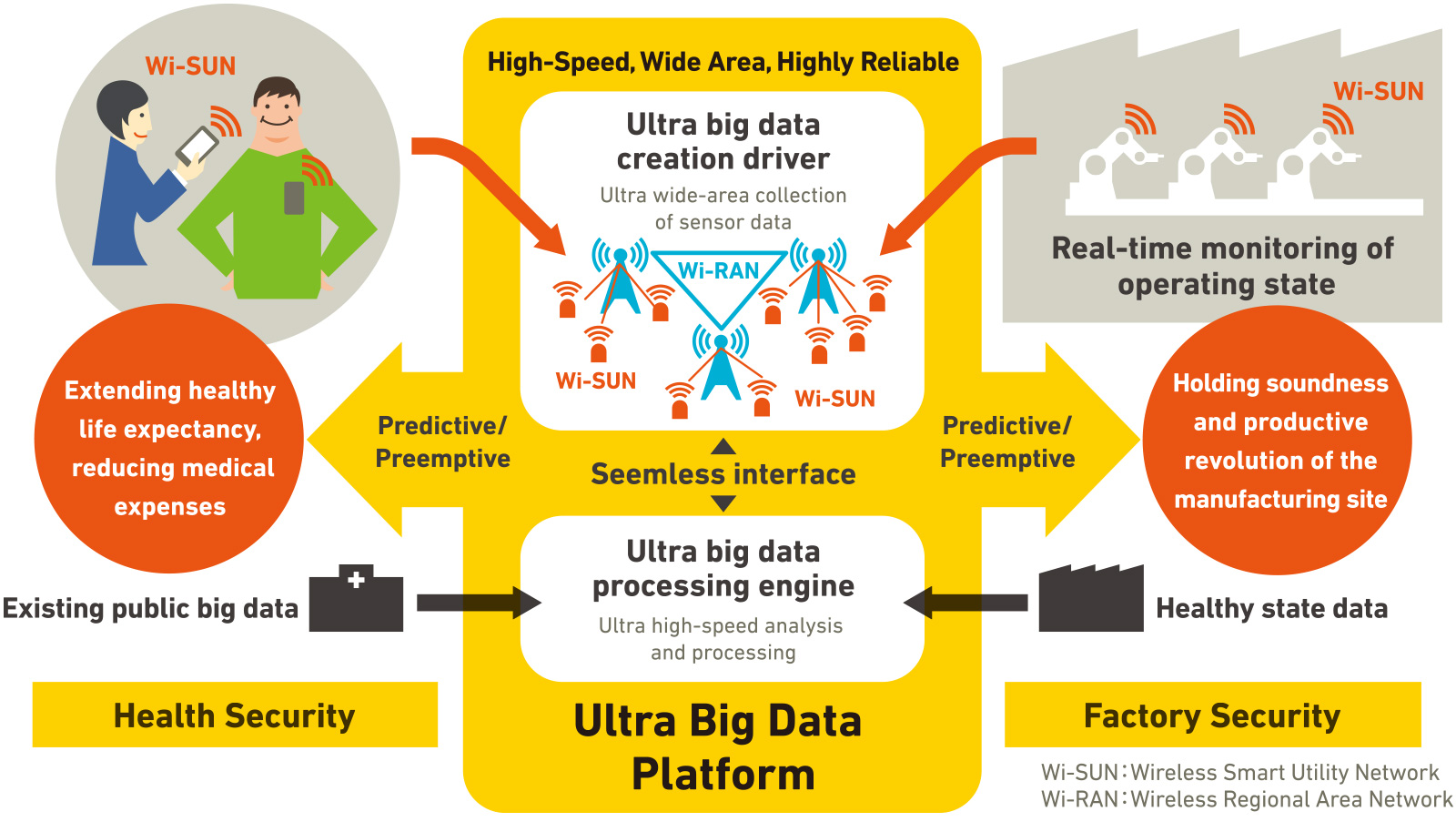

Disruptive Innovation
Keys to the breakthrough
- Building an ultra big data platform by combining a Big Data processing Engine (BDE) and a Big Data creation Driver (BDD)
- Achieving the early realization of strategic applications such as HS using ultra big public medical data and FS using high-speed, large-volume real-time big data from factories
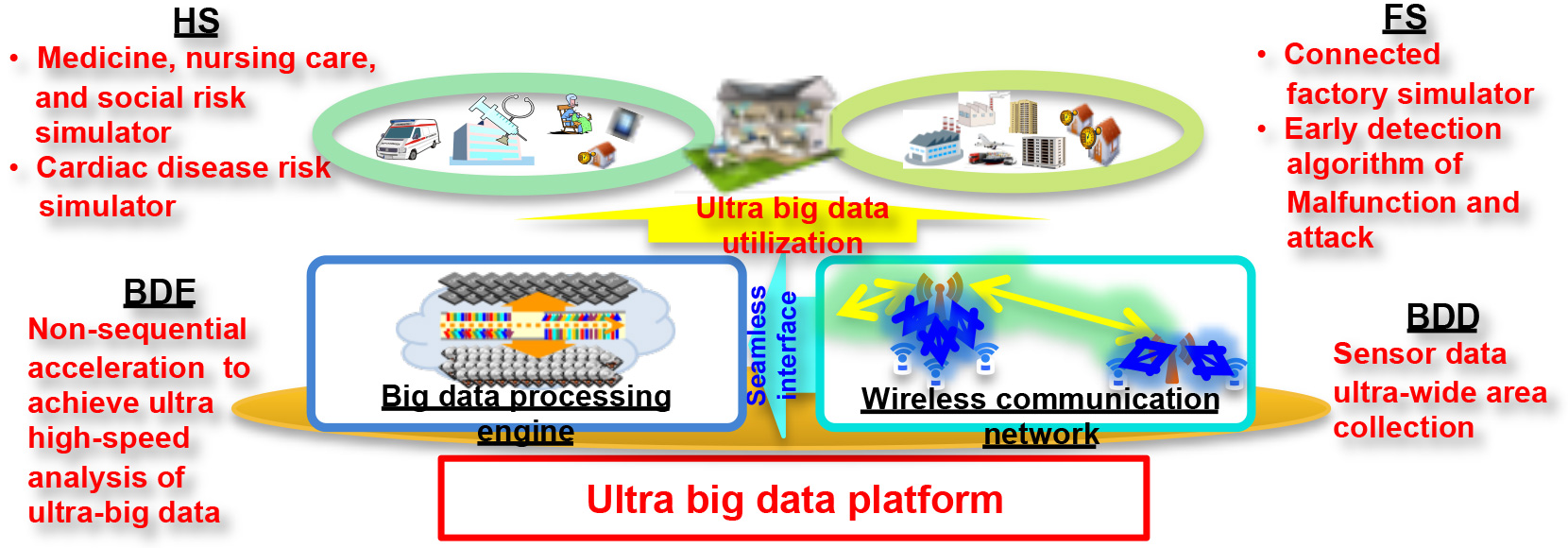
The Challenges for the PM and the Impact of Success
Overview and background
- There are more than 100 billion sensor devices ready to be connected to network around the world, but as of 2013 only a small percentage of these devices were actually connected and capable of sending data.
- More so, there is no existing platform capable of processing several tens of billions of data records in several minutes.
- To address this, we will construct an ultra big data platform that far exceeds the scale of today’s big data processing.
- Using this platform, we will use national and local public medical data and continuous measurement data to offer predictive and preemptive healthcare and medical services, through which we will achieve Health Security (HS) that helps us extend healthy life expectancy and reduce medical costs.
- We also aim to realize the social application of Factory Security (FS), which helps eliminate cyberattacks on factories and improve productivity and profitability by safely connecting control devices in factories into groups of one thousand units.
What is the impact to industry and society if achieved?
- This program aim to generate an economic effect on a scale from several hundred billion to several trillion yens.
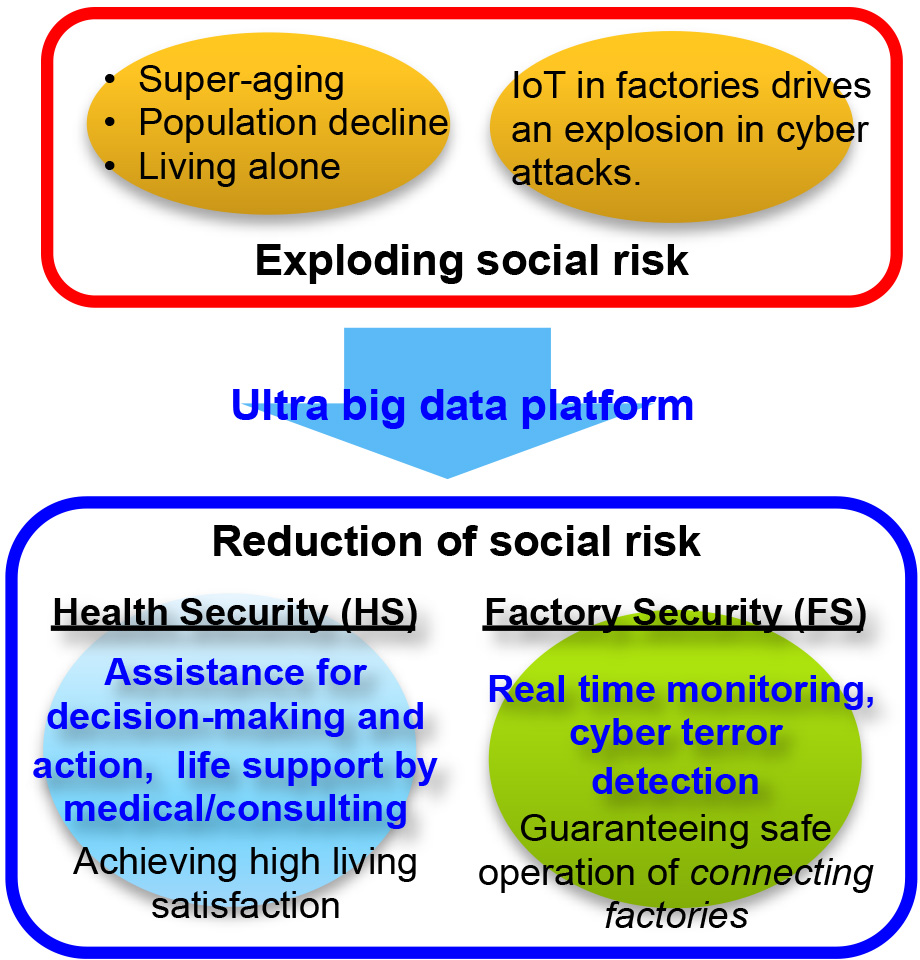
Scenario for Success and Achievement Targets
Method of resolution for success (Approach)
- We will construct an ultra big data platform that far exceeds the scale of today’s big data processing. Using this platform, we will use national public and local medical data and continuous measurement data to offer predictive and preemptive healthcare and medical services, through which we will achieve HS that helps extend healthy life expectancy and reduce medical costs. We also aim to realize the social application of FS, which will help eliminate cyberattacks on factories and improve productivity and profitability by safely connecting control devices in factories into groups of one thousand units.
Management strategy
- Combining two major technologies, BDE and BDD
- Using Japan's public medical big data records (billions of records)
- Implementing cooperation with internal/external researchers (hosting workshops)
Achievement targets
- Achieving ultra high-speed analysis 100,000 times faster than conventional approach
- Collecting big data generated from tens of thousands of monitors and sensors distributed over an area ranging in size from several kilometers to several tens of kilometers
- Managing to prevent serious manifestation or recurrence and reducing medical costs by reevaluating medical system and plans
- Early detection of malfunctions and attacks to eliminate cyber attacks on factories and improving the productivity and profitability of “connected factories” in a healthy manner
Risks
- Although compliance-related issues at the targets of the study and the cooperating municipalities may pose a significant risk to big data collection, close collaboration is already under way with the targets of the study, so the risk is almost zero.
Overall R&D Program Structure Created by the PM
This program will be comprised of the following four projects and the Implementation & Utility project fusing together the results of each individual project.
Comprised of the “Narrow-area Wi-SUN System” (BDD1) and “Wide-area Wi-RAN System” (BDD2) subprojects (SPs). The former will use a distributed autonomous structure to develop a high-speed, efficient, smart wireless network that gathers data from monitors and sensors distributed over an area several kilometers wide. The latter will be in charge of a multi-hop, ultra wide area, highly efficient wireless relay line network that connects this area over a range of several tens of kilometers. These will be used to gather and control several tens of billions of records, generated daily while maintaining high reliability and a high response speed (several 10ms).
Based on the knowledge gained through the research results of the previous R&D support program (the FIRST Program), this project will develop a non-order-type big data engine capable of analyzing, within several minutes, the massive big data generated on a daily basis (several tens of billion records per year). This will be expanded to a cloud scale and implemented as an ultra high-speed processing engine.
Comprised of SPs that will develop simulators; for “Medical, Nursing Care and Social Risks” (HS1), using tens of billions of public medical big data records and conducting ultra high-precision macro estimates based on the individual, region, time, etc, and for “Cardiac disease Risks” (HS2), using consecutive-measurement big data collected in a super wide area
Comprised of the “Connected Factory Simulator” (FS1) and “Malfunction/Attack Detection Algorithm” (FS2) SPs. The former will develop a simulator that outputs command flows to sequencer (PLC) assembly and processing machinery (robots) after a production plan is input. The latter will be in charge of a malfunction and attack early-detection algorithm that uses these results and real-time data from actual factories to improve factory health and productivity.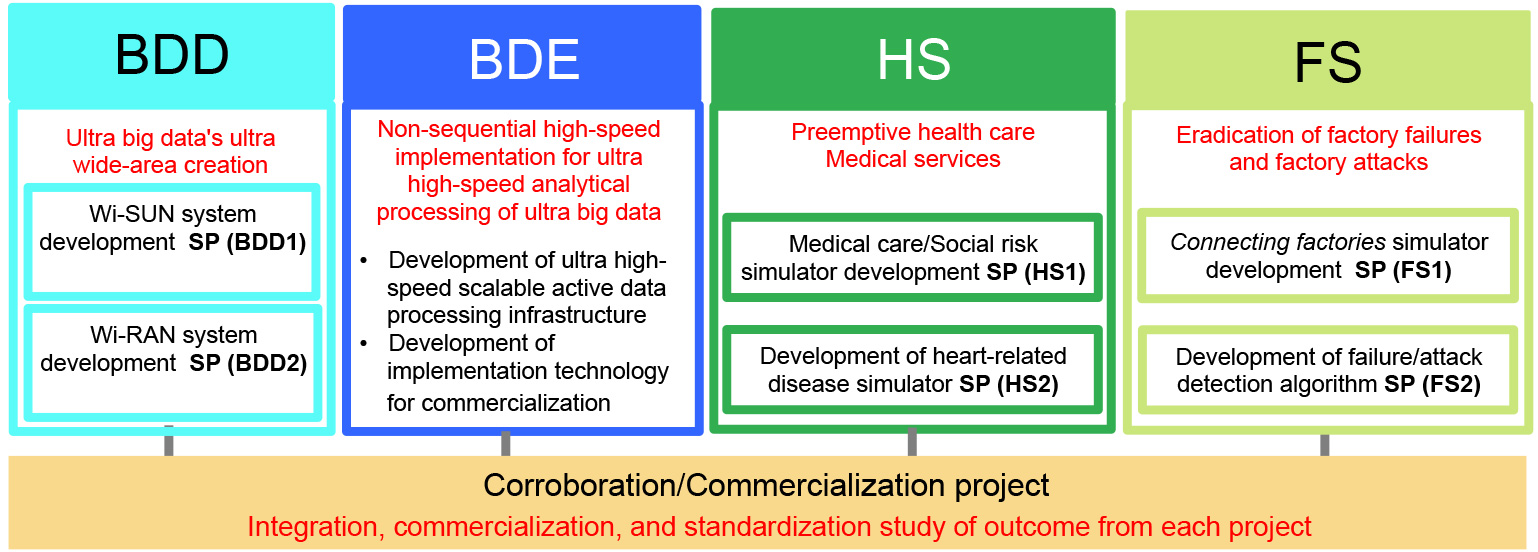
Ultra Big Data creation Driver project (BDD)
Comprised of the “Narrow-area Wi-SUN System” (BDD1) and “Wide-area Wi-RAN System” (BDD2) subprojects (SPs). The former will use a distributed autonomous structure to develop a high-speed, efficient, smart wireless network that gathers data from monitors and sensors distributed over an area several kilometers wide. The latter will be in charge of a multi-hop, ultra wide area, highly efficient wireless relay line network that connects this area over a range of several tens of kilometers. These will be used to gather and control several tens of billions of records, generated daily while maintaining high reliability and a high response speed (several 10ms).
Ultra Big Data processing Engine project (BDE)
Based on the knowledge gained through the research results of the previous R&D support program (the FIRST Program), this project will develop a non-order-type big data engine capable of analyzing, within several minutes, the massive big data generated on a daily basis (several tens of billion records per year). This will be expanded to a cloud scale and implemented as an ultra high-speed processing engine.
Health Security project (HS)
Comprised of SPs that will develop simulators; for “Medical, Nursing Care and Social Risks” (HS1), using tens of billions of public medical big data records and conducting ultra high-precision macro estimates based on the individual, region, time, etc, and for “Cardiac disease Risks” (HS2), using consecutive-measurement big data collected in a super wide area
Factory Security project (FS)
Comprised of the “Connected Factory Simulator” (FS1) and “Malfunction/Attack Detection Algorithm” (FS2) SPs. The former will develop a simulator that outputs command flows to sequencer (PLC) assembly and processing machinery (robots) after a production plan is input. The latter will be in charge of a malfunction and attack early-detection algorithm that uses these results and real-time data from actual factories to improve factory health and productivity.

Implementation Structure as Assembled by the PM
Approach to selection of institutions
For program success, the world‘s top researchers and research institutions have been selected in the fields of wireless communications technology, big data processing technology, health security, and factory security. The research structure is built around the following Project Leaders (PLs): Harada (Kyoto Univ.) whose track record includes his international leadership in wireless communications; Kitsuregawa (The Univ. of Tokyo) and Nagai (Jichi Medical Univ.) who have produced superb results in data information processing and medical information for the Cabinet Office FIRST Project; and Hayakawa who boasts a world class track record in the field of security/factory automation. The structure above will be the core, around which, new research institutions will be recruited as needed.
Keys of the implementation structure
- BDD (Wi-SUN and Wi-RAN) will be researched at institutions that have a track record in R&D, standardization, and commercialization for the respective topic.
- BDE will be researched at an institution that has a track record for non-sequential big data processing engines and has R&D and commercialization capability.
- HS will be researched at an institution that has access to national public medical and regional medical databases (from the perspective of access to regional medical databases, national receipt data analysis, national DPC (Diagnosis Procedure Combination) data analysis, and future social security needs estimation) and a track record in risk simulator development.
- FS will be researched at an institution that provides comprehensive FA solutions for productivity improvements, covering factory automation and even energy savings management. The institution will also have a track record in attack detection security based on international standards.
- Input from legal, business strategy, and international strategy advisers will be incorporated. Research outcomes will be proactively publicized through workshops and other events.
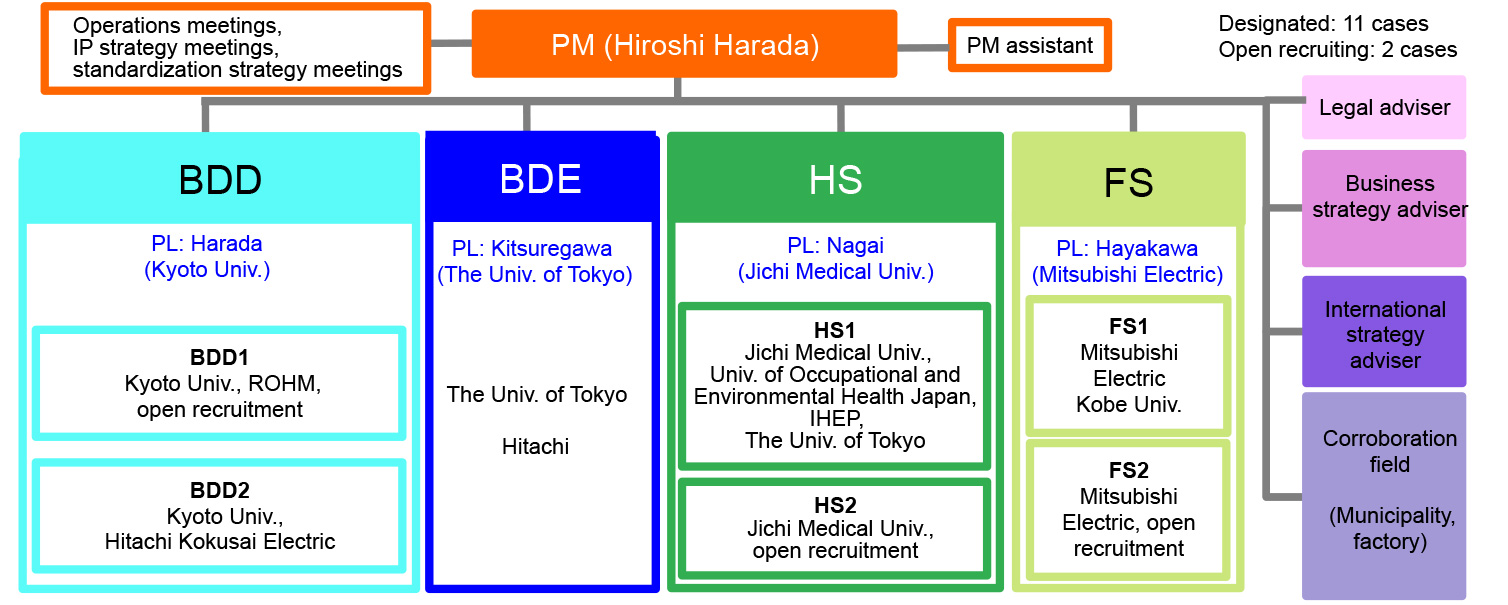
Organization
The Cabinet Office
ImPACT: An Ultra Big Data Platform for Reducing Social Risk
Hiroshi Harada
ImPACT: An Ultra Big Data Platform for Reducing Social Risk
Hiroshi Harada
Associate Program Manager
Makoto Kato
Makoto Kato

